24 Accelerating Obesity: Food Insecurity
Sabine Zempleni

Embedded from gettyimages.com
Food insecurity describes the inability to purchase enough food for every member of a household to enable a healthy and active life. There is the misconception though that food insecurity means starving, stunted children and underweight adults. Food insecurity is much more complex than that.
For starters Americans are not either food secure or insecure. Food security is a spectrum ranging from high food security to very low food insecurity.
Some Americans become temporarily food insecure after losing a job or becoming sick. Once the issue is resolved, they become food secure again. Others stay food insecure after becoming disabled by a chronic disease. Many Americans have such a tight budget that a car repair, unexpected health care expenses or an accident at a job can force the family to decide between paying bills and eating. Many American children live in an environment where they keep transitioning in and out of food insecurity with detrimental effects to their development, physical and mental health.
Food insecurity is complex and does not exist in isolation. It is often connected to a lack of affordable housing, social isolation, chronic or acute health problems, high medical costs, and low wage jobs. But, not all people living below the poverty line experience food insecurity. On the other hand people living above the poverty line can experience food insecurity.
Food insecurity can impact health in multiple ways. Aside of the impact on mental health cheap food tends to be energy dense and lacks nutrients. Food insecure Americans are disproportionally affected by obesity, T2D, high blood pressure, and CVD. Food insecurity also often forces people to go without medication or health care to be able to eat.
During this chapter we will look at food insecurity from the perspective of a growing child.
You Will Learn:
- Food security is a spectrum ranging from high food security to very low food insecurity
- The spectrum includes four levels: High, marginal, low, and very low food security
- A validated USDA questionnaire is used to measure food insecurity in a consistent and comparable way
- Food insecurity hovers around 12% and very-low food insecurity around 4% of US households
- Some population groups in the US are more vulnerable to food insecurity:
- Households with children especially housholds headed by single mothers
- Black households are especially vulnerable to being food insecure
- Obesity in food insecurity is due to an eating pattern of energy-dense, starchy, sugary cheap foods and alternating periods of deprivation and overconsumption
- Food insecurity impacts academic achievement, health and behavior of children
- Consequences of food insecurity vary by age group
- Repeated shifting in and out of food insecurity is stressful for children
- Key-determinant of the effects of food insecurity on children is the mother-child interaction
Food Insecurity Is a Spectrum Ranging From High Food Security to Very Low Food Insecurity
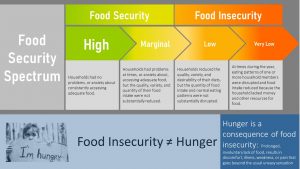
When you look at the infographic above food security is classified as a spectrum with four levels: High, marginal, low, and very low food security. Low and very low food security are considered food insecurity.
A family is considered having high food security if the family has no problems consistently buying adequate amounts of quality food. People with high food security are not anxious about being able to buy enough quality foods and this is the case for most American households.
As people worry more about food, we get into the area of marginal food security. Those families are worrying sometimes that they might not be able to buy adequate amounts of quality foods before the next pay check comes in. They might also resort at times to purchasing cheap foods low in nutrients and rich in energy. People on marginal food security tend to overcome those difficulties and their quantity, variety, and quality of food is not substantially reduced.
If the situation gets worse, families slip into food insecurity. Low food security means that the quantity of food is not substantially disrupted, but the family makes do by reducing the quality and variety of foods. These families are still getting enough calories, but their diet will lack variety and often consist mainly of cheap, packaged carbohydrate foods such as packaged pasta and rice dishes or cheap pizza. Veggetables, fruits and quality meats are not affordable.
We talk about very low food insecurity when one or more family members start skipping meals or reduce the quantity of food eaten at a meal.
It is important that we do not confuse food insecurity and hunger. Hunger is the physical sensation of discomfort if not enough food is eaten. Food insecurity refers to the lack of financial resources to purchase adequate quality and quantity of food. Hunger and food insecurity are related, and hunger can be the consequence of very low food security, but insecurity can exist without hunger.
A Validated USDA Questionnaire Is Used to Measure Food Insecurity In a Consistent and Comparable Way
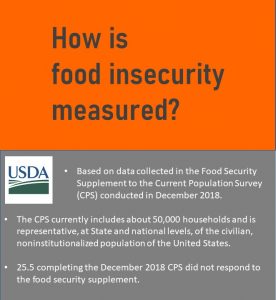
Scientists or people working with food programs are not just eye balling if somebody is food insecure. The USDA has developed a validated questionnaire that allows scientists, health officials, and policy makers to determine food insecurity in a consistent and comparable way.
Every two years, the USDA conducts the so called current population survey (CPS). 50,000 representative US households are selected to complete the survey. The food security questionnaire is tucked to the CPS. In 2018 about 75% of households completing the CPS also completed the food security supplement.
The CPS food security supplemental questionnaire has 11 questions for the adults in a household. Families with children have an additional 8 questions. Go over the questionnaire and calculate your level of food security:
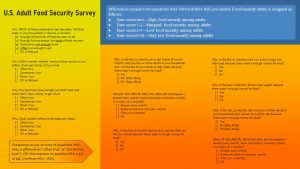

The questions HH1 to HH4 are screening questions. If the household answers all screener questions in the negative the houshold is considered to have a high food security: They don’t worry about food and have always sufficient amounts of money to buy enough quality food.
If the household answers only one of the screener questions affirmatively the entire questionnaire is completed. With exception of question HH1 the number of affirmatively answered questions is added. When households answer three or more questions in an affirmative way, the household is considered food insecure. People are classified as very low food secure if they answer six and more questions affirmatively.
Food Insecurity Hovers Around 12% and Very-Low Food Insecurity Around 4% of US Households

The graph above shows you how surveyed households answered the adult survey questions in 2020. People with very low food security checked most of the the first 6 questions and then some of the ones that indicate more severe food insecurity. They changed their eating pattern (frequency, amount, quality) but also reported feeling hungry, losing weight, or not eating for an entire day.
The green bars indicate people that answered the screener questions affirmatively but are marginally food secure. It is not surprising that families or people with marginal food security answer affirmatively to the first three of the questions. Marginal food insecurity includes by definition people who are occasionally worried that food might run out or that the food they bought does not last or that they had to eat cheap meals occasionally.
When you look at the conditions the food questionnaire probes for, it becomes clear that food insecurity can look differently for each household.
If the household includes children under the age of 18 the questionnaire is expanded by questions probing specifically for child-related situations. The evaluation is similar. The affirmative answers for the child section are also counted and added to the adult score. See the questionnaire above for details.
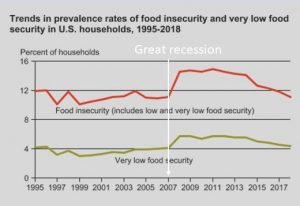
The graph to the right shows the results of the CPS food security supplemental questionnaire over the last 25 years. The graph distinguishes between all food insecurity (red line) and then separates very low food security (green line).
In the US food insecurity tends to hover around 12%, while very low food security hovers around 4% of the American population. The increase you see in 2007 is due to the housing market crash and the great recession. It took several years for the food insecurity prevalence to get back to baseline.
Newer data for 2020 are not available yet, but it is expected that the Covid-19 pandemic caused another spike in the prevalence food insecurity.
Some Population Groups in the US Are More Vulnerable to Food Insecurity
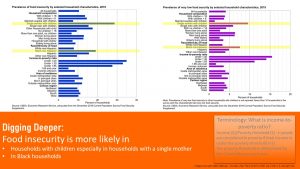
Food insecurity is not evenly distributed in the US. First and foremost food insecurity is tied to low wage jobs. People on low hourly wages are even more at risk because. A sick child or parent or less available work hours can quickly push the family into food insecurity. Less hours worked means less wages. Combined with the lack of affordable housing in a community, social isolation, chronic or acute health problems, and high medical cost, households often need to decide between paying rent and food, electricity and food, or health care costs and food.
Families with children are more vulnerable to experience several of those factors and are much more likely to experience food insecurity. Even more vulnerable are single mothers with children.
The other population groups with a disproportionately high prevalence of food insecurity are Black Americans.
Why Is Income and Education Attainment Lower in the Black Community? By Selena Ramirez Ahilon
Public policies such as redlining, restrictive covenants, and discrimination in the rental market and sale of housing are all factors that have contributed to the segregated neighborhoods witnessed in inner cities across the country which have resulted in the unequal distribution of property wealth.
Redlining was a discriminatory practice by the US Federal Housing Administration to rate neighborhoods in the aftermath of the Great Depression to reduce risky mortgages. Neighborhoods with mostly black residents or areas close to black neighborhoods were marked on maps in red—hence redlining—suggesting risky for investment. As a consequence, banks and insurances refused or limited loans, mortgages, or insurance in those neighborhoods.
This practice made homeownership—the most important wealth-building strategy in the US—impossible for Black Americans. Black Americans were not able to hand wealth accumulated in a house from generation to generation as white Americans were able to.
Similarly, racially restrictive covenants—contractual agreements between a homeowner and a neighborhood—did not allow homeowners to rent, sell, and transfer properties to specific races or religious groups, thus further enhancing racial segregation. Such policies were abolished in the Shelley vs. Kraemer case in 1948 and by the fair housing act of 1968, but to this day some neighborhoods still have those illigal racially restrictive covenants on the books (https://www.npr.org/2021/11/17/1049052531/racial-covenants-housing-discrimination.) Even if racially restrictive covenants are illigal today they had a lasting impact on the many segregated communities across the country.
How does racial segregation in large cities and small towns all over the US manifest in educational disparities? Residential segregation has unfortunately resulted in differential values of properties across the country. This impacts school quality.
School funding comes from three sources: local, state, and federal. Federal and state funding is similar in all school districts in a state. The main contributor to differences in school funding is the local property tax portion. If the property value of the school district is low school funding will also be low. Low property tax receipts profoundly impact school quality in poorer communities.
The clear impact of unequal allocated resources resulting from unequal property value distribution is seen in districts such as the Chicago Ridge School District in Illinois, where the amount of funding this school had in 2013 was three times lower than that of another district located just less than an hour away in Chicago’s suburbs. This difference in funding is witnessed across the nation, most prominently when comparing rural and urban areas to suburban areas.
The situation is even more aggravated by the housing that many teachers have. Very few teachers live in the areas in which they teach. The book by Fasching-Varner Working through Whiteness: Examining White Racial Identity and Profession With Pre-Service Teachers discusses how teachers working in urban schools live in suburban neighborhoods. While they earn money paid by urban property taxes, they pay part of those wages as property tax on their suburban housing which is funneled into suburban school investments.
Without speculating too much, it is not surprising that Hispanic and Black minority groups have lower educational attainment given the fact that many African American and Hispanic individuals come from a low-income background and tend to reside traditionally in areas with low-property value and low educational investment. The consequences of the discriminatory housing practices of the 1930s are affecting the educational attainment of racial minorities to this day.
Households With Children Are Especially Vulnerable to be Food Insecure

Having children increases the risk for food insecurity substantially because feeding and clothing children, day care costs, and health care are generally expensive.
Parents with children might not be able to work as much as they need to. Parents with a job that pays hourly wages are in an especially difficult position. Hourly paid jobs are often low-income jobs and the need of taking care of a sick child will cut the work hours quickly since sick leave is not available for those jobs. This additional loss of already low wages might force the family to decide between paying bills and buying food.
You already know that food insecurity hovers around 12% in the US. But, if we look at families with children (graph above), food insecurity is much higher in families and during the last recession it really spiked.
Why is food insecurity in children lower than food insecurity in housholds with children (orange line.) The reason for this is that parents forego food first. Having a parent going without sufficient quality or quantity of food makes the houshold food insecure. In addition, children in food insecure housholds are eligible for free school breakfast and lunch programs at school. This is why we see a lower prevalence for children when we separate food insecurity in children from the family. Still, during the last 25 years between 7-11% of children were food insecure despite programs such as school breakfast and lunch programs.
Single mothers with children are at an especially high risk. Single mothers with children have a 5 to 10% higher food insecurity prevalence than single fathers with children and an almost 15% higher prevalence than married couples with children.
Obesity In Food Insecurity Is Due to an Eating Pattern of Energy-Dense, Starchy, Sugary Cheap Foods and Alternating Periods of Deprivation and Overconsumption
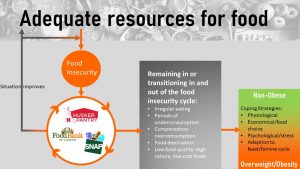
When we think of food insecurity, we tend to think of hunger. When we think of hunger, we think of starvation. This is a misconception. Today, we need to rethink what food insecurity looks like. People living in food insecurity have a high risk for becoming overweight and obese and ultimately develop chronic diseases. Here is why:
The US offers resources for food insecure families. These resources will come from government programs or private sources.
The first problem is that food insecure Americans might feel ashamed and therefore not seek out help. Often families have money to buy food when a paycheck comes in but at the end of the pay period they run out of money. This means that the family goes through cycles of undernutrition and adequate eating. Many make up with overeating when the new paychecks comes in.
If food insecure families seek help, this help consists of food banks, SNAP (Supplemental Nutrition Assistance Program), school lunch programs, and WIC (Special Supplemental Nutrition Program for Women, Infants, and Children). Relying on those resources can also lead to irregular eating because SNAP is not a generous amount of money and might not last through the month, and food banks limit the number of visits.
The consequence is periods of food under-consumption and deprivation altered by periods of compensatory overconsumption.
The quality of food provided by those resources often does not meet the recommendations for children. SNAP funds allow people to choose foods at the grocery store but if those dollars need to be stretched people might rather go for cheap calories than quality food. Most foodbanks offer packaged foods with a long shelf life which tends to be mostly low quality food. Refrigeration is expensive so frozen or fresh fruits and vegetables, dairy, and fresh meat are not commonly stocked.
Lately, efforts are under way so food insecure people have the opportunity to purchase inexpensive vegetables for example by using their SNAP dollars at farmer’s markets and getting double dollars if they buy fruits and vegetables.
Hopefully families use SNAP and food banks only temporarily and move back into food security after a short period. The impact of food insecurity on the health of children varies widely. It depends on how long the family remains food insecure or how frequently they transition into and out of food insecurity. Impact also varies by the coping strategies the parents have developed.
For families that regularly transition in and out of food insecurity or families who are long-term food insecure, health depends on their ability to cope with the situation. Do the parents have financial skills so they are able to budget the limited resources? Do they know how to choose healthy, quality, inexpensive food? Do they know how to prepare meals using for example dried legumes and other cheap, but nutritious foods? How are they coping with the stress of being food insecure? Do they have psychological coping skills, or are they slipping into anxiety and depression?
The Impact of Food Insecurity On Children’s Health Varies and Depends on the Parents’ Coping Skills
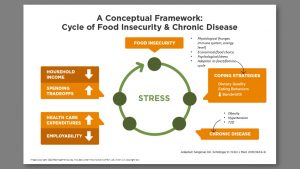
If parents lack coping skills they are much more likely to become overweight and obese. Theses parents go into the cycle of deprivation and overconsumption. Lacking nutritional knowledge the diet becomes increasingly calorie rich and delivers little nutrients. This leads over time to obesity and chronic diseases.
Chronic diseases add now another high cost to the already strained budget. Health care and medication are extremely expensive in the US. Dealing with the symptoms of a chronic disease, more sick days, and doctor visits make the food insecure person less employable. Household income becomes even more strained and the family might now be permanently in food insecurity. At this point, it is not likely that the family reaches food security again without help.
Understanding this very complicated connection between food insecurity and obesity will allow you to understand why the science cannot demonstrate a clear connection between the two. While some studies find a clear connection between food insecurity and obesity, others don’t. Obesity in food insecurity depends very much on the duration of the food insecurity and the coping skills of parents.
Food Insecurity Impacts Academic Achievement, Health, and Behavior of Children
Many children growing up in food insecure households are at increased risk for obesity and future chronic diseases. This is not the only consequence of food shortages for those children.
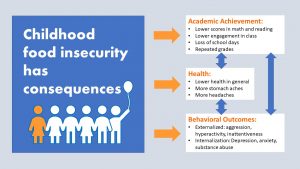
The consequences of food insecurity in children is well researched. According to this research, the consequences affect three different areas: Academic achievement, behavior, and overall health.
Before I talk more about the research, I would like to address something important. We all heard about families living in poverty with a strong single mother enabling her children to be successful. On the other hand, we hear about families staying in poverty for generations. When you hear these reports, keep in mind that these are individual stories. Often people make up their mind about food insecurity and poverty based on those extremes. While health care providers work with individual families and should adjust their approach to the client, we also need to understand the consequences of food insecurity by looking at the general trends replicated in multiple studies.
Those studies found that children experiencing food insecurity are more likely to have lower scores in math and reading, are less engaged in class, miss more school days, and are more often in need to repeat grades. Food insecurity is not a condition that enables a child to learn effectively because food insecurity is a stressful situation.
When children don’t have access to quality foods such as lean meats, vegetables and fruits, they will have lower health in general. Eating lots of low quality calories increases the risk for obesity. Lack of fresh food especially fruits and vegetables will lead to sub-optimal nutrient intake and can make children more prone for infections. The stress of poverty and food insecurity makes for a stressful family life. As a consequence, children display more stomach aches and headaches. Poorer health can affect their focus and performance in school.
The stress of food insecurity leads to a higher amount of externalized behaviors such as aggression, hyperactivity, and inattentiveness. Other children internalize the stress with depression and anxiety, and teens may turn to substance abuse.
These consequences don’t affect every food insecure family equally and outcomes vary for each individual child living in a food insecure family.
Consequences of Food Insecurity Vary by Age Group
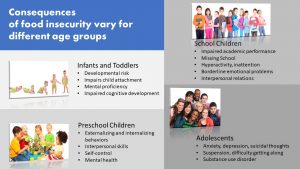
When scientists dig deeper, they see that consequences of food insecurity varies by age group.
Infant and toddlers grow fast, undergo significant foundational brain development, and are fully dependent on the caretaker (which is most often the mother). Infants or toddlers need loving attachment to their parents and an abundance of stimulation to reach their full potential. Stressed parents living in food insecurity do not make for attentive, relaxed parents. Their thinking is swallowed up by how to pay the bills and where the next meal comes from. Depending on the severity of the food insecurity, infants and toddlers in food insecure households might display an impaired attachment to parents and impaired mental and cognitive development.
Preschoolers are more aware of the situation at home and might externalize the stress of food insecurity. A lack of self-control, hyperactivity, and aggressive behaviors are examples of externalization. Other preschool children internalize. Mental health and interpersonal skills are a concern in this group of children.
When food insecure children start school, they might display an impaired academic performance and might miss school often. Behavioral and borderline emotional problems can make the child a difficult student. This can be misinterpreted as bad behavior, resulting in disciplinary action by the school.
In adolescents, behaviors can be either internalized or externalized. In addition to substance abuse, eating disorders start appearing.
What we established so far:
- The consequences of food insecurity are highly individual.
- How a child reacts depends on the age of the child and the social environment.
- The stress of living in food insecurity can be externalized or internalized.
- Food insecurity can affect academic performance, behavior and health.
Food Insecurity Tends to be a Transient State Generating a High Level of Stress
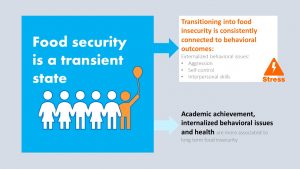
We also need to keep in mind that food security can be a transient state. Families might experience marginal food security but then slip into low or very low food security because a parent loses a job or a sick family member needs to be taken care of which reduces family income. Once the challenges are solved the family might move back into marginal food security but the next catastrophe might send them back into food insecurity. People living on a tight income are at risk since they cannot cushion disease, job loss, or increases in cost of living.
When a child transitions into food insecurity it will generate a high level of stress for the entire family. In this situation the child is more likely to externalize the stress. The child might lose self-control easily or overreact. Interpersonal skills with peers or teachers might be low.
Internalized behaviors and a drop in academic achievement are more consistent with long-term food insecurity.
Key-Determinant of the Effects of Food Insecurity on Children is Mother-Child Interaction
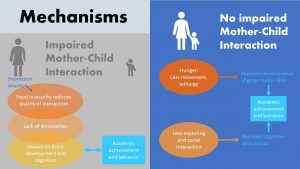
Why are some families living with food insecurity more stable than others? Research found that one of the modifiers how food insecurity impacts children is the mother-child interaction.
A mother that is constantly worrying about how to make ends meet and feed her children is more likely to suffer from depression and anxiety. Constant depression and anxiety overwhelms parents and leads to a reduction of interaction with their child.
Depressed parents are less likely to play with, cuddle, or read to their children. This lack of stimulation especially in the first years of life impact the child’s brain development and reduces cognition. These changes tend to impact academic achievement down the line.
Even if the interaction between mother and child is not impaired, severe food insecurity will still impact the development of the child. A hungry child (or parent) will move less and be more lethargic. A hungry child tends to spend less time exploring or interacting with others. This lack of movement is associated with reduced gross motor skills and reduced cognitive stimulation. A child with those deficiencies is not well prepared for learning and engaging in school.
A child that tends to behave aggressively, is often depressed, and has less social skills will have a deficit in learning. The consequence is all too often that the teen will not successfully complete education. A lack of education will lead to a low-wage job, and the person starts the cycle of food insecurity all over.
Aside of the humanitarian aspect, breaking this cycle saves money. Ensuring that children and families have a sufficient food supply will allow them to perform better in school. This does not only apply to academic success but also social interactions and a more positive outlook on life. The child will grow into a functioning adult that is able to find and maintain a job paying sufficient money to support a content life.
What is the Solution?
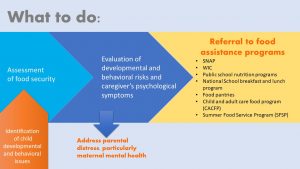
Children living in food insecurity need to be identified. This can happen at a pediatrician’s office or be completed by other health care workers. If a preschool or school detects developmental or behavioral issues the child should be assessed for food insecurity.
Other important aspects are the careful evaluation of the family. Addressing parental distress and particular maternal mental health will start the process of breaking the cycle. Additionally, overweight and obese children and mothers may be misconceived as having an abundance of food thus making some providers overlook food insecurity as a cause.
A food insecurity screening process allows providers to address all patients and avoid singling out families based on assumptions.
If it is established that the family drifts in and out of food insecurity, food assistance programs are the next step. In the US there are multiple layers of food assistance programs. The main USDA programs are SNAP, WIC, and the National School Lunch Program. These programs are supplemented by many other programs. Some are funded by the federal or state government or rely on grants and donations.
Important is that families slipping into food insecurity are identified and then educated about the different programs. Keep in mind that for most Americans accepting help is not easy, and many need help navigating paper work for federal programs.
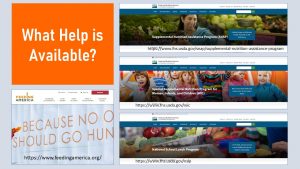
This chapter scratches only the surface of food insecurity. If you were fortunate to never be close to food insecurity this information will hopefully challenge you to become more aware. If you are interested in more information feedingamerica.org is a good place to start.
Confused about food insecurity and poverty terminology? https://www.census.gov/topics/income-poverty/poverty/about/glossary.html
2018 CPS report: https://www.ers.usda.gov/webdocs/publications/94849/err-270.pdf?v=963.1
SNAP: https://www.fns.usda.gov/snap/supplemental-nutrition-assistance-program
SNAP Education: https://snaped.fns.usda.gov/
National School Lunch Program: https://www.fns.usda.gov/nslp
WIC: https://www.fns.usda.gov/wic
Editor: Eric Hanzel, Gabi Ziegler
NUTR251 Contributors:
- Spring 2020: Jordan Juracek, Taylor Donner, Brittany Southall, Eugene Baraka, Melanie Nissen, Kenyon Gaar, Haley Jensen, Brett Freitag, Kealy Barnes, Ericka Knapp, Elliot Glaser, Max Kleinschmit, Rose Davidson, Kendyl Heuertz, Alondra Iturbide, Patrick Fisher
- Fall 2020: Morgan McCain, Ken Zhao, Collin Mahler, Peyton Hainline, Clare Caraghar


Feedback/Errata